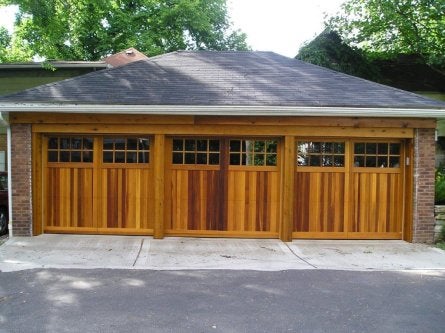When shopping for a garage door there are four main types of materials to choose from. It is important to be an informed consumer when making large purchasing decisions. Therefore, here is everything you need to know about the pros and cons of each material.
Steel

Steel has a long track record of being used in garage doors since the 40s. Steel doors are stronger and resist twisting and kinking better than other materials.
When looking at a steel door, the most important part is its gauge. The lower the gauge number, the thicker the steel and the more resistant the door will be to dents. Always try to get a door with a 24 gauge.
Some manufacturers will not mention the thickness or will say “nominal” gauge. This means that the door is 30 gauge which is not what you want. You should never buy a door with a gauge higher that 27 as this is the recommended thickness to give you any lasting durability.
The only cons to using a steel door would be dents from hitting the door too hard and possible rusting if the door is not properly maintained by washing the door twice a year. They are the most popular door for use in both residential and commercial applications.
Vinyl
Vinyl doors have been out for around 20 years, but because of low customer satisfaction many installers have stopped selling them. Vinyl is much more elastic than wood or steel which means it expands more in warm temperature and shrinks more in cold temperature.
If you live in an area with variable temperatures and legitimate seasons, you should never consider vinyl because over time the front of your door will be in bad shape with holes and warping.
You should only consider a vinyl door if you live in an area where it is consistently warm and weather changes are not common.
Wood

From the early 50s through the mid-80s, wood doors were most common. They were usually constructed with horizontal wooden rails and vertical styles making a framework to hold floating Masonite (particle board) panels.
After taking a dip in popularity, wood is coming back as a popular option today. Some doors are combined with steel and other have wooden panels with insulation in between.
Wooden doors are considerably more expensive than other materials and take much more to maintain. Staining and painting is required consistently every two to four years.
Despite this, the aesthetic appeal and warm feeling of a wooden door is unsurpassed.
Fiberglass
Fiberglass doors have been around for over 25 years. Using a heavy gauge fiberglass, these doors can come pre-finished in a specific color or stain or they are available in a “stainable” version allowing you to stain the door in whatever color yourself.
Modern fiberglass doors have steel frames and insulation sandwiched between the front fiberglass skin. They can have a realistic wood-like appearance but don’t have the price premium that wood doors currently have. However, fiberglass doors do require a clear coat resealing every one to three years for proper maintenance.
In conclusion, steel doors are the most reliable, have the least amount of maintenance, and are the cheapest of all the materials. Vinyl doors are not recommended unless you live in an area where it is always warm. Wooden doors are the most expensive and require a lot of maintenance, but they have the best aesthetic appeal. Fiberglass can give you the look of wood for less money but still has more maintenance compared to a steel door.
Have more specific questions about a material? Let us know in the comments!
Thomas V. Giel Garage Doors serves the greater Pittsburgh area in all things garage doors. We have maintenance programs for both commercial and residential to keep your doors working like new.

